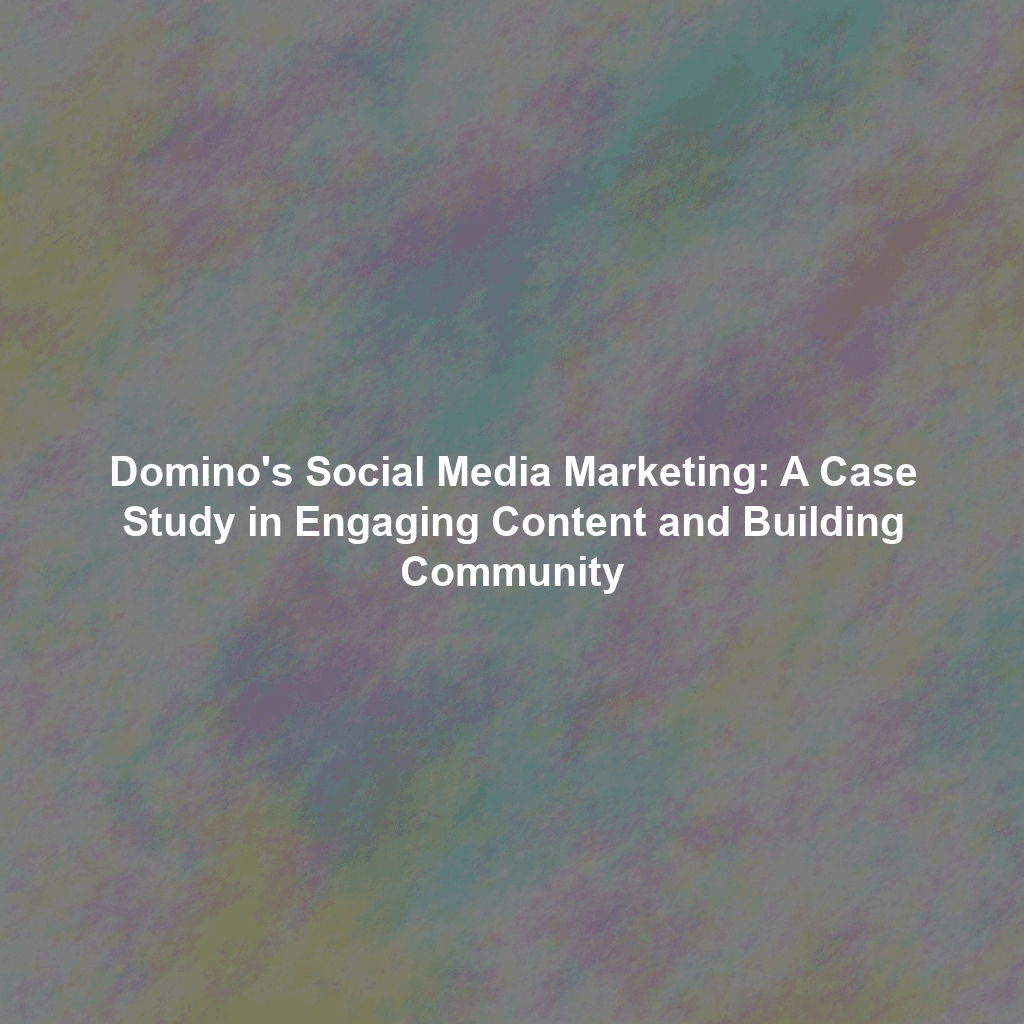In the bustling world of fast-food marketing, few brands have mastered the art of social media engagement quite like Domino’s. More than just posting mouthwatering photos of pizza, Domino’s has cultivated a dynamic online presence that fosters community, builds brand loyalty, and drives sales. This article delves into Domino’s social media strategy, examining successful campaigns, audience engagement tactics, and the clever integration of user-generated content. We’ll explore how they effectively leverage platforms like Twitter, Facebook, and Instagram to stay top-of-mind in the competitive pizza delivery landscape. Understanding Domino’s success provides valuable insights into modern “pizza marketing on social media”.
Domino’s Social Media Dominance: More Than Just Pepperoni
Domino’s understands that social media is more than just a broadcast channel; it’s a two-way conversation. Their strategy focuses on building genuine relationships with their audience through a blend of humor, responsiveness, and valuable content. This approach has allowed them to transform social media from a marketing tool into a powerful customer engagement platform.
Twitter: Quick Wit and Real-Time Engagement
Domino’s Twitter presence is characterized by its quick wit and real-time engagement. They actively monitor mentions, respond to customer queries (both positive and negative), and participate in trending conversations. Their playful tone and willingness to engage in humorous banter have earned them a reputation as a relatable and approachable brand.
Example: During a major sporting event, Domino’s might use a relevant hashtag to offer special deals or run a contest, encouraging followers to share their pizza-fueled game-day celebrations. They are also quick to acknowledge and resolve customer issues publicly, demonstrating transparency and a commitment to customer satisfaction.
Facebook: Building Community and Sharing Visual Delights
On Facebook, Domino’s focuses on building a strong community through engaging content, interactive polls, and mouthwatering visuals. They regularly post high-quality photos and videos of their pizzas, showcasing their ingredients and preparation methods. They also run contests and giveaways to incentivize engagement and expand their reach.
Example: A successful Facebook campaign might involve asking fans to share their “perfect pizza topping combinations” for a chance to win a free pizza. This not only generates engagement but also provides valuable insights into customer preferences. Domino’s also uses Facebook to announce new product launches and promotions, ensuring that their audience is always in the know.
Instagram: Visual Storytelling and Influencer Marketing
Instagram is Domino’s visual playground. They leverage high-quality photography and videography to showcase their pizzas in aesthetically pleasing ways. They also partner with food bloggers and influencers to reach a wider audience and generate buzz around their products.
Example: Domino’s might collaborate with a popular food blogger to create a visually stunning post featuring a new pizza creation. The blogger would then share the post with their followers, tagging Domino’s and encouraging them to try the new pizza. This approach allows Domino’s to tap into the blogger’s established audience and build credibility.
The Power of User-Generated Content
One of the key ingredients in Domino’s social media success is their effective use of user-generated content (UGC). They actively encourage customers to share photos and videos of their Domino’s experiences using specific hashtags. This UGC not only provides valuable social proof but also helps to build a sense of community around the brand.
Example: Domino’s might run a campaign asking customers to share photos of their “Domino’s pizza nights” using a specific hashtag. They would then feature the best photos on their social media channels, giving the customers recognition and further incentivizing others to participate. This not only generates a stream of fresh, authentic content but also makes customers feel valued and appreciated.
Successful Domino’s Social Media Campaigns: Learning from the Best
Domino’s has a history of launching innovative and highly successful social media campaigns. Here are a few examples that highlight their strategic approach:
- The “Pizza Turnaround” Campaign: Acknowledging past criticisms about their pizza quality, Domino’s launched a campaign inviting customers to provide honest feedback. This transparency and willingness to improve earned them significant goodwill and ultimately led to improved products.
- Domino’s AnyWare: This campaign allowed customers to order pizza through various platforms, including Twitter, smart TVs, and even smartwatches. This innovative approach showcased Domino’s commitment to convenience and technology.
- Paving for Pizza: Recognizing the annoyance of potholes for pizza delivery, Domino’s launched a campaign to help communities repair roads. This clever and altruistic campaign generated significant media coverage and positive brand sentiment.
Key Takeaways for Pizza Marketing on Social Media
Domino’s social media strategy provides valuable lessons for any brand looking to succeed in the digital age:
- Be authentic and relatable: Don’t be afraid to inject humor and personality into your social media presence.
- Engage with your audience: Respond to comments, answer questions, and participate in relevant conversations.
- Embrace user-generated content: Encourage customers to share their experiences and feature the best content on your channels.
- Be innovative and experimental: Don’t be afraid to try new things and push the boundaries of social media marketing.
- Monitor and analyze: Track your social media performance and use data to refine your strategy.
Conclusion
Domino’s social media strategy is a testament to the power of engaging content, authentic communication, and a deep understanding of your audience. By leveraging platforms like Twitter, Facebook, and Instagram, Domino’s has built a thriving online community, strengthened its brand loyalty, and driven significant business results. Their success serves as a valuable case study for any brand looking to master the art of “pizza marketing on social media” and beyond. By focusing on customer engagement, embracing user-generated content, and consistently delivering high-quality content, Domino’s has solidified its position as a social media powerhouse in the fast-food industry. Their innovative campaigns and willingness to connect with customers on a personal level have set a new standard for “Domino’s social media strategy” and serve as a benchmark for other brands to aspire to.
 Skip to content
Skip to content

